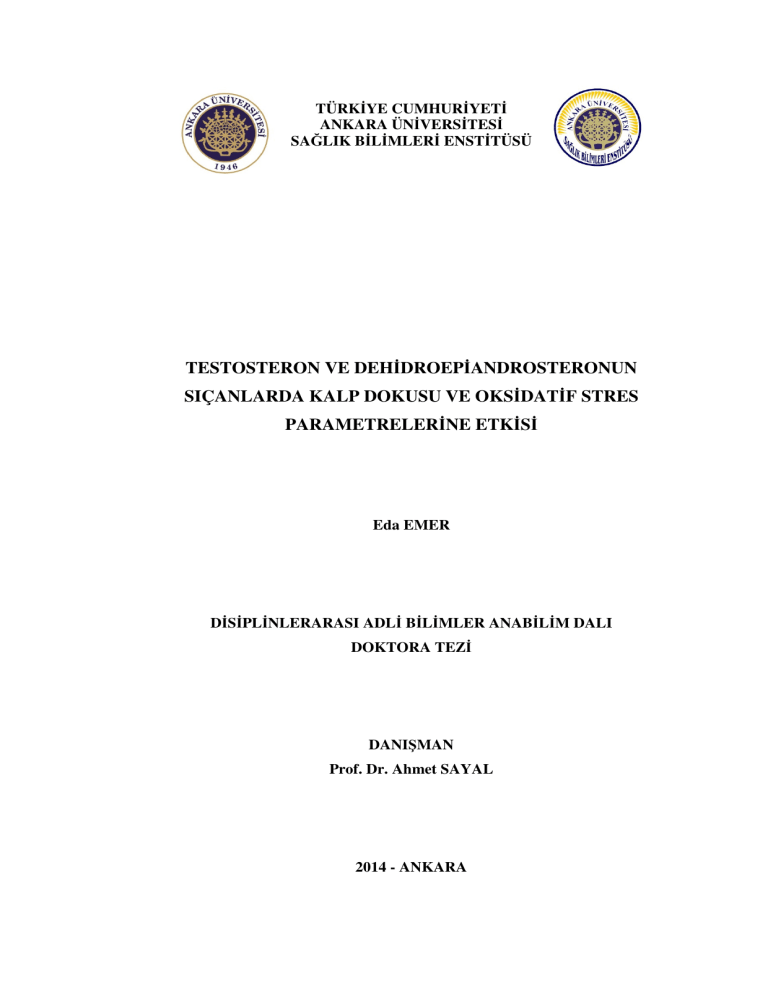
TÜRKİYE CUMHURİYETİ
ANKARA ÜNİVERSİTESİ
SAĞLIK BİLİMLERİ ENSTİTÜSÜ
TESTOSTERON VE DEHİDROEPİANDROSTERONUN
SIÇANLARDA KALP DOKUSU VE OKSİDATİF STRES
PARAMETRELERİNE ETKİSİ
Eda EMER
DİSİPLİNLERARASI ADLİ BİLİMLER ANABİLİM DALI
DOKTORA TEZİ
DANIŞMAN
Prof. Dr. Ahmet SAYAL
2014 - ANKARA
86
ÖZET
Testosteron ve Dehidroepiandrosteronun Sıçanlarda Kalp Dokusu ve Oksidatif
Stres Parametrelerine Etkisi
Bu tez çalışmasında amaç testosteron ve dehidroepiandrosteron (DHEA)’un akut ve kronik
uygulanmasının Sprague-Dawley cinsi sıçanlarda ekokardiyografik, patolojik, biyokimyasal ve
oksidatif stres parametrelerine etkileri araştırılmasıdır.
Çalışmamızda temel olarak sıçanlarda subkronik ve subakut testosteron ve DHEA’nın
ekokardiyografik parametrelere, kalpte oluşturdukları morfolojik değişikliklere ve oksidatif stress
parametlerine etkisi kontrol grubu ile istatistiksel olarak karşılaştırılmıştır.
Bu tez çalışmasında subakut ve subkronik testosteron ve DHEA uygulamasıyla genel olarak,
vücut ağırlığının ve lökomotor aktivitenin azaldığı (p<0,05), kas gücünün ise arttığı (p<0,05)
sonucuna ulaşılmıştır. Patolojik değerlendirme sonuçlarına göre, özellikle 14. günde yüksek doz
(100mg/100g) TES uygulanan sıçanlarda hücre nükleusunda şekil bozuklukları, miyokard liflerinde
disorganizasyonlar ve lökositik infiltrasyonlar gözlenmiştir. Subkronik (90 gün) uygulamalarda ise
testosteronun tüm dozlarında ve DHEA’da orta derecede miyokardiyal lezyonlar (interstisiyel fibrozis,
lökositik infiltrasyon, bozuk şekilli nükleus, disorganize miyokardiyal lifler) gözlenmiştir.
Ekokardiyografi sonuçlarına göre 14. ve 90. günlerde testosteronun yüksek dozlarında sol ventriküler
posterior duvar kalınlığındaki ve ejeksiyon fraksiyonunda artış gözlenmiştir (p<0.05). Bu çalışmada
oksidatif stres belirteci MDA düzeylerinin testosteron ve DHEA uygulanan gruplarda istatistiksel
olarak anlamlı olmayan derecede arttığı SOD ve GSHPx düzeylerinin ise azaldığı gözlenmiştir.
Sonuç olarak uzun süreli ve yüksek doz AAS kullanımı kalpte muhtemel zararlı etkiler
oluşturmaktadır ve insanlarda kullanımı sınırlandırılmalıdır.
Anahtar Sözcükler: Anabolik
testosteron, , oksidatif stres.
androjenik
steroid,
dehidroepiandrosteron,
ekokardiyografi
87
SUMMARY
The Assessment of The İmpact of Testosterone ond Dehydroepiandrosterone on
Hearth Tissue And Oxidative Stress Parameters in Rat
The aim of this study is to asses the impact of subacute and subchronic administration
testosterone and dehydroepiandrosterone on echocardiographic, pathologic and oxydative stress
parameters in Sprague-Dawley rats.
In our study, we compared the impact of subacute and subchronic administration testosterone
and dehydroepiandrosterone on echocardiographic and morphological parameters in heart and
oxydative stress markers with the control group.
In this study, we have approached the conclusion that subacute and subchronic testosterone and
DHEA administration decreased the body weights and locomotor activity (p<0,05), and they increased
muscle strength (p<0,05) in rats. According to our pathological assesment, mishappen cell nuclei,
interstitial fibrosis, disorganized myocardial fibers and leukocytic infiltrates were observed in high
dose testosterone (100mg/ 100gr) –treated rats especially on 14th day. In subchronic (90 days)
testosterone and DHEA treatment groups, mild changes such as mishappen cell nuclei, interstitial
fibrosis, disorganized myocardial fibers and leukocytic infiltrates were observed. According to our
echocardiographic study at 14th and 90th days, testosterone, especially at high doses, induced increase
in left ventricular posterior wall diameter and ejection fraction (p<0.05). In this study, oxidative stress
marker MDA increased slighty but significantly in testosterone and DHEA groups.On the other hand,
SOD and GSHPx levels were slighty but not significantly increased intestosterone and DHEA groups.
In conclusion, long term and high dose AAS administration has been found to create possible
deleterious effects on heart and should be strongly discouraged in human subjects.
Key Words: Anabolic androgenic steroid, dehydroepiandrosterone, echocardiography, testosterone,
oxydative stress
